2002 HONDA ODYSSEY ECU
[x] Cancel search: ECUPage 14 of 399

To make sure you and your
passengers get the maximum
protection f rom your vehicle’s saf ety
f eatures, check the f ollowing each
time before you drive away:All adults, and children who have
outgrown child saf ety seats, are
wearing their seat belts and
wearingthemproperly(seepage ).
Any inf ant or small child is
properly restrained in a child seat
in a back seat (see page ). The rest of this section gives more
detailed inf ormation about how you
can maximize your saf ety.
Remember, however, that no saf ety
system can prevent all injuries or
deaths that can occur in severe
crashes, even when seat belts are
properly worn and the airbags deploy.
Frontseatoccupantsaresitting
upright and as f ar back as possible
f rom the steering wheel and
dashboard (see page ).
Seat-backs are upright (see page
).
Head restraints are properly
adjusted (see page ).
Alldoorsandthetailgateare
closed and locked (see page ).
All cargo is properly stored or
secured (see page ).
15
22 12
13 1412
241
Driver and Passenger Saf ety
Your Vehicle’s Saf ety Features
Pre-Drive Saf ety Checklist
11
Page 15 of 399

The f ollowing pages provide
instructions on how to properly
protect the driver and other adult
occupants.
These instructions also apply to
children who have outgrown child
seats and are large enough to wear
lap/shoulder belts. (See page f or
important additional guidelines on
how to properly protect larger
children.)Your vehicle has a door and tailgate
monitor light on the instrument
panel to indicate when a specif ic
door or the tailgate is not tightly
closed. Af ter everyone has entered the
vehicle, be sure the doors and
tailgate are closed and locked.
For security, locked doors can
prevent an outsider f rom
unexpectedly opening a door when
you come to a stop.
See page f or how to lock the
doors. For saf ety, locking the doors reduces
the chance that a passenger,
especially a child, will open a door
while the vehicle is moving and
accidentally f all out. It also reduces
the chance of someone being thrown
out of the vehicle during a crash.
Any driver who sits too close to the
steering wheel is at risk of being
seriously injured or killed by striking
the steering wheel or f rom being
struck by an inflating front airbag
during a crash.
41
82
Driver and Passenger Saf ety
Protecting Adults
Introduction A djust the Front Seats
Close and L ock the Doors
1. 2.
12
Page 18 of 399
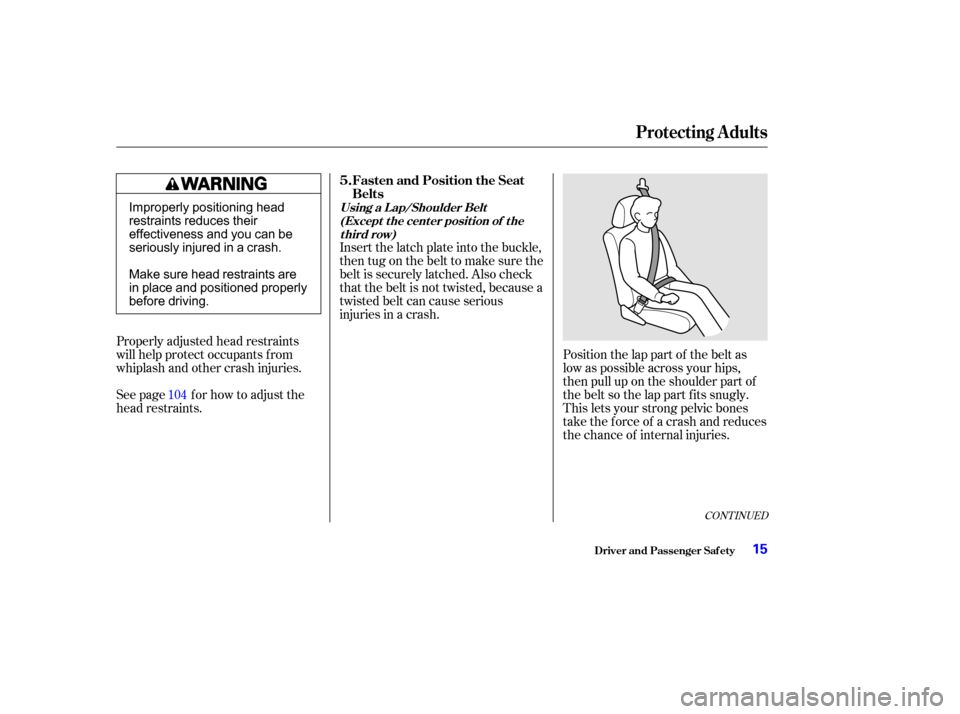
CONT INUED
Position the lap part of the belt as
low as possible across your hips,
then pull up on the shoulder part of
thebeltsothelappartfitssnugly.
This lets your strong pelvic bones
take the force of a crash and reduces
the chance of internal injuries.
Insert the latch plate into the buckle,
then tug on the belt to make sure the
belt is securely latched. Also check
that the belt is not twisted, because a
twisted belt can cause serious
injuries in a crash.
Properly adjusted head restraints
will help protect occupants f rom
whiplash and other crash injuries.
See page f or how to adjust the
head restraints. 104
Driver and Passenger Saf ety
Protecting Adults
Fasten and Position the Seat
Belts
5.
Using a L ap/Shoulder Belt
(Except t he cent er posit ion of t hethird row)
15
Improperly positioning head
restraints reduces their
effectiveness and you can be
seriously injured in a crash.
Make sure head restraints are
in place and positioned properly
before driving.
Page 20 of 399
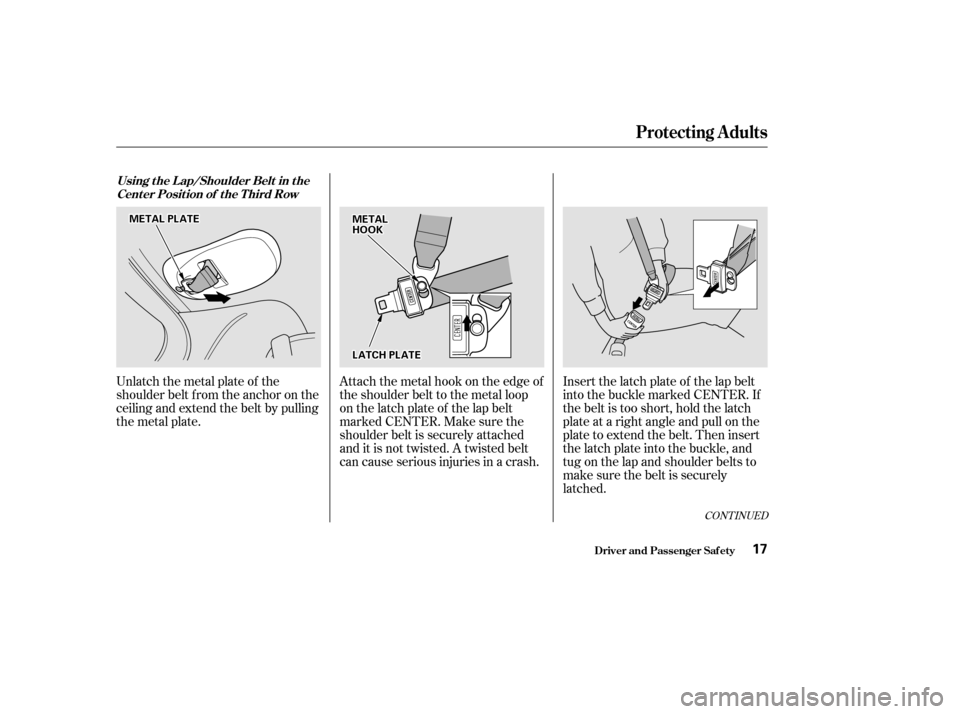
Unlatch the metal plate of the
shoulder belt f rom the anchor on the
ceiling and extend the belt by pulling
the metal plate.Attach the metal hook on the edge of
the shoulder belt to the metal loop
on the latch plate of the lap belt
markedCENTER.Makesurethe
shoulder belt is securely attached
and it is not twisted. A twisted belt
can cause serious injuries in a crash.Insert the latch plate of the lap belt
into the buckle marked CENTER. If
the belt is too short, hold the latch
plate at a right angle and pull on the
plate to extend the belt. Then insert
the latch plate into the buckle, and
tug on the lap and shoulder belts to
make sure the belt is securely
latched.
CONT INUED
Protecting Adults
Driver and Passenger Saf ety
Using t he L ap/Shoulder Belt in t he
Cent er Posit ion of t he T hird Row
17
M M E
ET
TA
A L
L P
PL
LAA T
TE
E
M
ME
ET
TA
A L
L
H
H O
OO OKK
L
LA A T
TC
CH H P
PL
LAA T
TE
E
Page 29 of 399
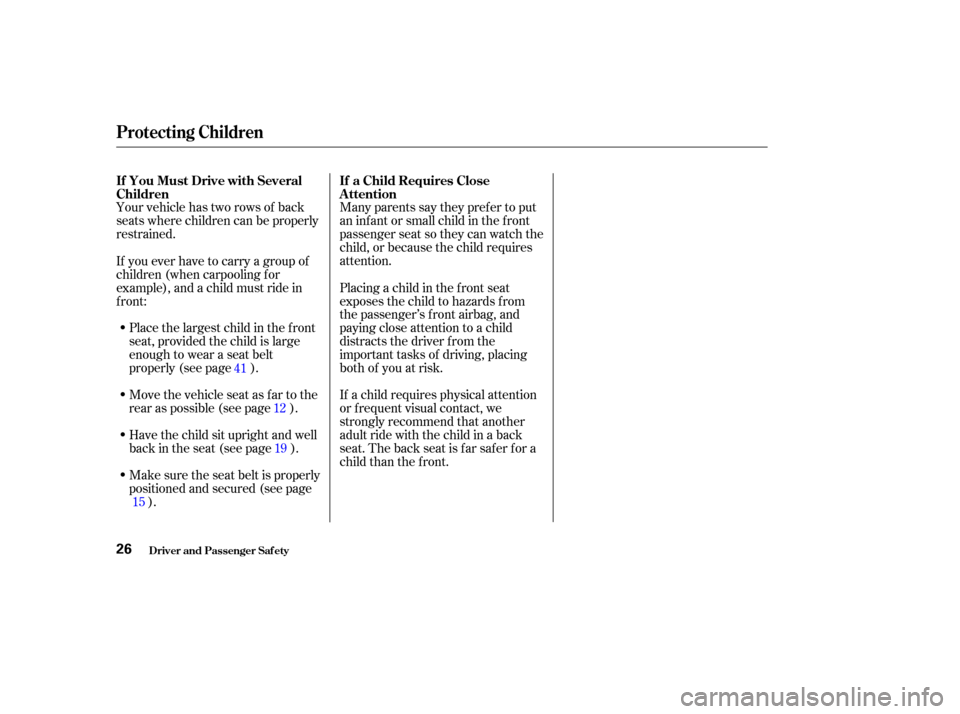
Many parents say they pref er to put
an inf ant or small child in the f ront
passenger seat so they can watch the
child, or because the child requires
attention.
Your vehicle has two rows of back
seats where children can be properly
restrained.
Place the largest child in the f ront
seat, provided the child is large
enough to wear a seat belt
properly (see page ).
Move the vehicle seat as far to the
rear as possible (see page ).
Have the child sit upright and well
backintheseat(seepage ).
Make sure the seat belt is properly
positioned and secured (see page ).
If you ever have to carry a group of
children (when carpooling f or
example), and a child must ride in
front:
Placing a child in the f ront seat
exposes the child to hazards f rom
the passenger’s f ront airbag, and
paying close attention to a child
distracts the driver f rom the
important tasks of driving, placing
both of you at risk.
If a child requires physical attention
or f requent visual contact, we
strongly recommend that another
adult ride with the child in a back
seat. The back seat is far safer for a
child than the front.
12
19
15 41 If a Child Requires Close
Attention
If You Must Drive with Several
Children
Protecting Children
Driver and Passenger Saf ety26
Page 33 of 399
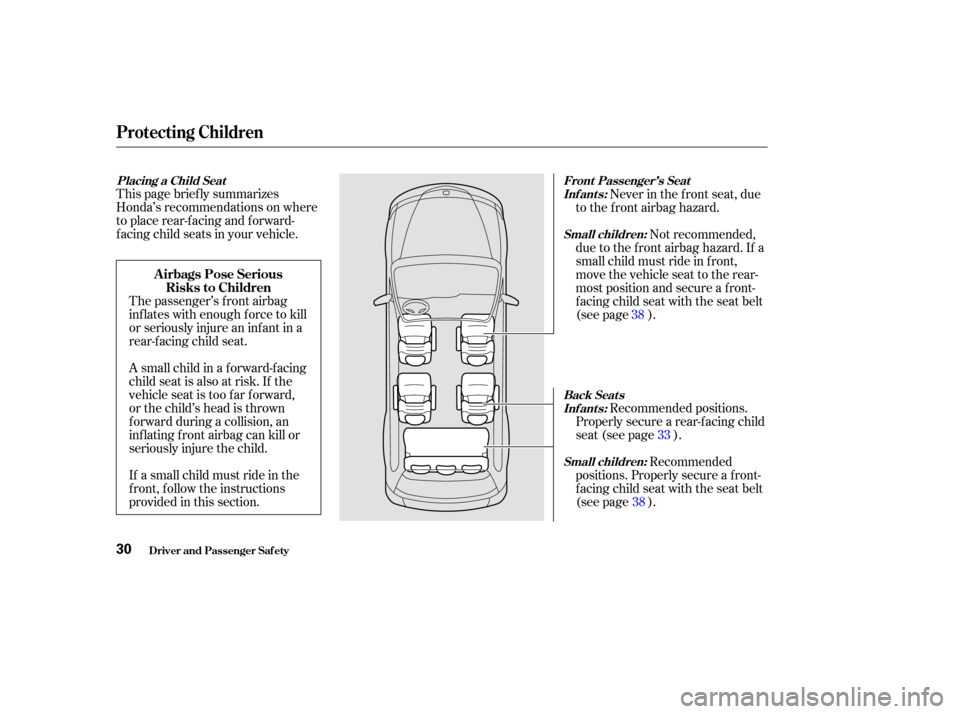
If a small child must ride in the
f ront, f ollow the instructions
provided in this section.
This page brief ly summarizes
Honda’s recommendations on where
to place rear-facing and forward-
f acing child seats in your vehicle.
Recommended
positions. Properly secure a f ront-
f acing child seat with the seat belt
(see page ). Recommended positions.
Properlysecurearear-facingchild
seat (see page ).
The passenger’s f ront airbag
inf lates with enough f orce to kill
or seriously injure an inf ant in a
rear-facing child seat.
A small child in a f orward-f acing
child seat is also at risk. If the
vehicle seat is too f ar f orward,
or the child’s head is thrown
f orward during a collision, an
inf lating f ront airbag can kill or
seriously injure the child. Never in the f ront seat, due
to the f ront airbag hazard.
Not recommended,
due to the f ront airbag hazard. If a
small child must ride in f ront,
move the vehicle seat to the rear-
most position and secure a f ront-
f acing child seat with the seat belt
(see page ).
33
38
38
Placing a Child Seat
Front Passenger’s Seat
Back Seat sSmall children:
Inf ant s:
Inf ant s:
Small children:
Airbags Pose SeriousRisks to Children
Protecting Children
Driver and Passenger Saf ety30
Page 34 of 399
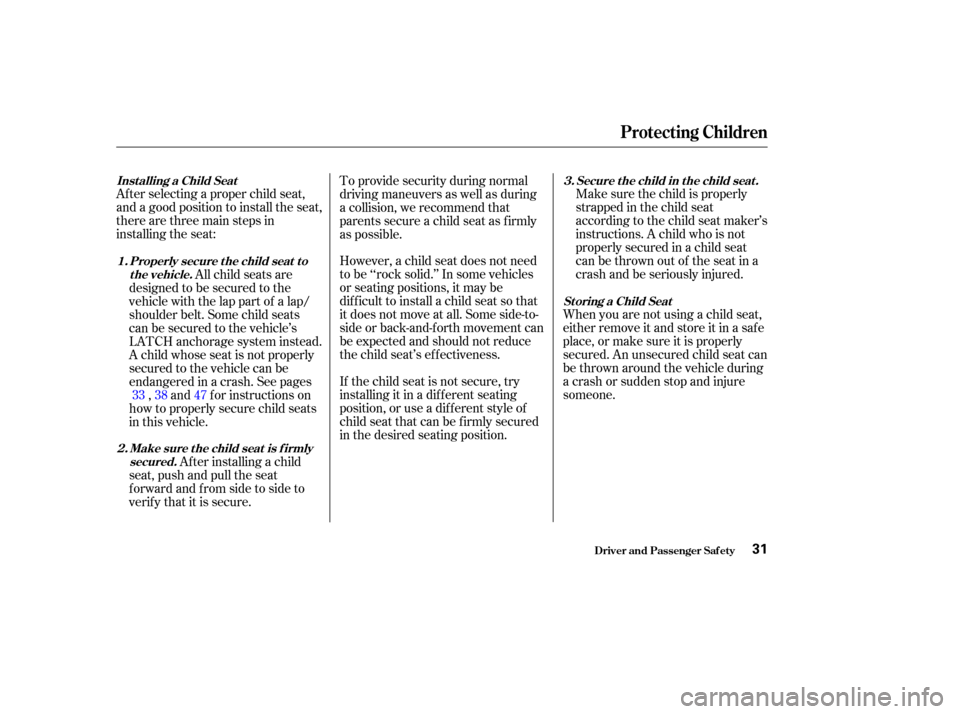
Af ter selecting a proper child seat,
and a good position to install the seat,
there are three main steps in
installing the seat:Make sure the child is properly
strappedinthechildseat
according to the child seat maker’s
instructions. A child who is not
properly secured in a child seat
canbethrownoutof theseatina
crash and be seriously injured.
However, a child seat does not need
to be ‘‘rock solid.’’ In some vehicles
or seating positions, it may be
dif f icult to install a child seat so that
it does not move at all. Some side-to-
side or back-and-f orth movement can
be expected and should not reduce
the child seat’s ef f ectiveness. When you are not using a child seat,
either remove it and store it in a saf e
place, or make sure it is properly
secured. An unsecured child seat can
be thrown around the vehicle during
a crash or sudden stop and injure
someone.
If the child seat is not secure, try
installing it in a dif f erent seating
position, or use a dif f erent style of
child seat that can be f irmly secured
in the desired seating position. To provide security during normal
driving maneuvers as well as during
a collision, we recommend that
parents secure a child seat as f irmly
as possible.
Af ter installing a child
seat, push and pull the seat
f orward and f rom side to side to
verif y that it is secure. All child seats are
designed to be secured to the
vehicle with the lap part of a lap/
shoulder belt. Some child seats
can be secured to the vehicle’s
LATCH anchorage system instead.
A child whose seat is not properly
secured to the vehicle can be
endangered in a crash. See pages , and f or instructions on
howtoproperlysecurechildseats
in this vehicle. 33 38 47
Inst alling a Child Seat
Secure t he child in t he child seat .
Storing a Child Seat
Make sure t he child seat is f irmly secured.
Properly secure t he child seat t o
the vehicle.
1.
2. 3.
Protecting Children
Driver and Passenger Saf ety31
Page 36 of 399
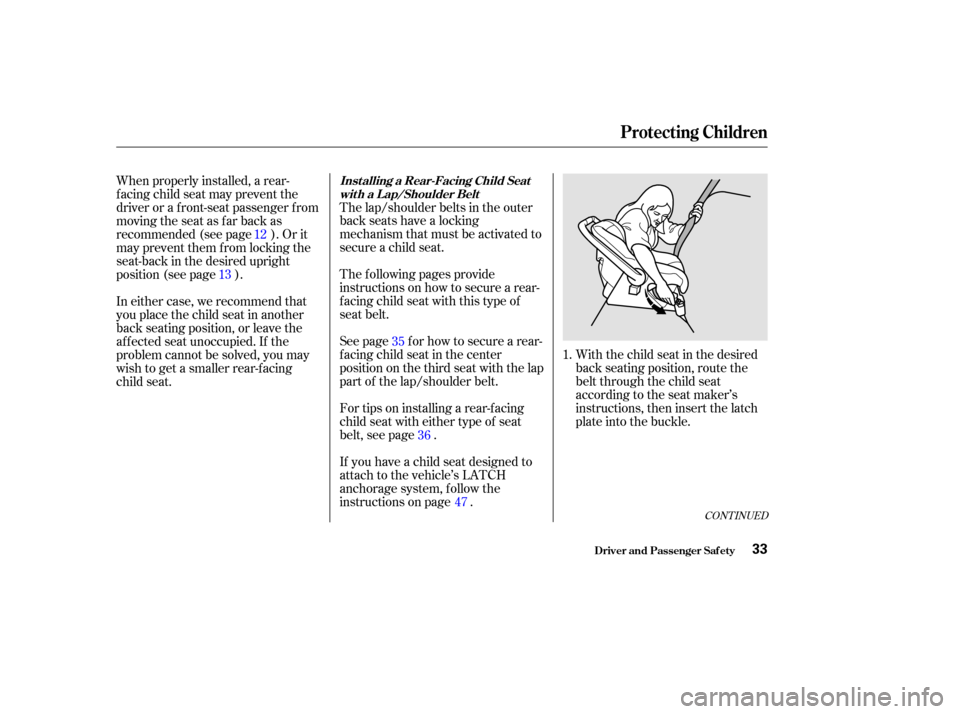
CONT INUED
With the child seat in the desired
back seating position, route the
belt through the child seat
according to the seat maker’s
instructions, then insert the latch
plate into the buckle.
The lap/shoulder belts in the outer
back seats have a locking
mechanism that must be activated to
secure a child seat.
The f ollowing pages provide
instructions on how to secure a rear-
facing child seat with this type of
seat belt.
See page f or how to secure a rear-
f acing child seat in the center
position on the third seat with the lap
part of the lap/shoulder belt.
For tips on installing a rear-f acing
child seat with either type of seat
belt, see page .
When properly installed, a rear-
f acing child seat may prevent the
driver or a f ront-seat passenger f rom
moving the seat as far back as
recommended (see page ). Or it
may prevent them f rom locking the
seat-back in the desired upright
position (see page ).
In either case, we recommend that
you place the child seat in another
back seating position, or leave the
af f ected seat unoccupied. If the
problem cannot be solved, you may
wish to get a smaller rear-f acing
child seat.
If you have a child seat designed to
attach to the vehicle’s LATCH
anchorage system, follow the
instructions on page .1.
35
36
12
47
13
Protecting Children
Driver and Passenger Saf ety
Inst alling a Rear-Facing Child Seat
wit h a L ap/Shoulder Belt
33